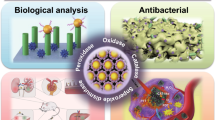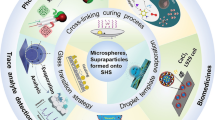Abstract
Poly(styrene-acrylic acid) magnetic microspheres with an average diameter of 2 μm were successfully prepared and used as carriers to immobilize lipase. Lipase immobilized on microspheres with no spacer arm exhibited low activities, which were attributed to steric hindrance on the lipase conformation. To avoid steric effects, ethylenediamine and poly(ethylene glycol) (PEG) 400/800/4000 were utilized as spacer arms to bind the lipase to the microspheres. The immobilized lipase activities were improved using PEG 800/4000 as a spacer arm. Furthermore, the influence of enzyme loading on lipase activity was investigated, and the results indicated that enzyme overloading could exert steric effect on lipase activity. The degree of PEG modification was demonstrated to affect lipase activity because excess PEG on the surface of microspheres could interact with lipase due to its mobility, consequently reducing lipase activity.
Similar content being viewed by others
References
Carrea, G. and S. Riva (2000) Properties and synthetic applications of enzymes in organic solvents. Angew. Chem. Int. Edit. 39: 2226–2254.
Reetz, M. T. (2002) Lipases as practical biocatalysts. Curr. Opin. Chem. Biol. 6: 145–150.
Gao, S. L., Y. J. Wang, W. W. Wang, G. S. Luo, and Y. Y. Dai (2010) Enhancing performance of lipase immobilized on methylmodified silica aerogels at the adsorption and catalysis processes: Effect of co-solvents. J. Mol. Catal. B: Enz. 62: 218–224.
Chen, B., M. E. Miller, and R. A. Gross (2007) Effects of porous polystyrene resin parameters on Candida Lipase B adsorption, distribution, and polyester synthesis activity. Langmuir 23: 6467–6474.
Fernandez-Lorente, G., Z. Cabrera, C. Godoy, R. Fernandez-Lafuente, J. M. Palomo, and J. M. Guisan (2008) Interfacially activated lipases against hydrophobic supports: Effect of the support nature on the biocatalytic properties. Proc. Biochem. 43: 1061–1067.
Li, Y., F. Gao, W. Wei, J. B. Qu, G. H. Ma, and W. Q. Zhou (2010) Pore size of macroporous polystyrene microspheres affects lipase immobilization. J. Mol. Catal. B: Enz. 66: 182–189.
Ge, J., D. N. Lu, J. Wang, and Z. Liu (2009) Lipase nanogel catalyzed transesterification in anhydrous dimethyl sulfoxide. Biomacromol. 10: 1612–1618.
Wang, Y. J. and F. Caruso (2005) Mesoporous silica spheres as supports for enzyme immobilization and encapsulation. Chem. Mater. 17: 953–961.
Bilkova, Z., M. Slovakova, N. Minc, C. Futterer, R. Cecal, D. Horak, M. Benes, I.I. Potier, J. Krenkova, M. Przybylski, and J. L. Viovy (2006) Functionalized magnetic micro- and nanoparticles: Optimization and application to μ-chip tryptic digestion. Electrophor. 27: 1811–1824.
Bruice, T. C. and P. Y. Bruice (2005) Covalent intermediates and enzyme proficiency. J. Am. Chem. Soc. 127: 12478–12479.
Carolan, N., R. J. Forster, and C. O. Fagain (2007) Covalent attachment of ferrocene to soybean peroxidase glycans: Electron transfer mediation to redox enzymes. Bioconjugate Chem. 18: 524–529.
Chiou, S. H. and W. T. Wu (2004) Immobilization of Candida rugosa lipase on chitosan with activation of the hydroxyl groups. Biomaterials 25: 197–204.
Knezevic, Z., N. Milosavic, D. Bezbradica, Z. Jakovljevic, and R. Prodanovic (2006) Immobilization of lipase from Candida rugosa on Eupergit® supports by covalent attachment. Biochem. Eng. J. 30: 269–278.
Das, R. D., S. Maji, S. Das, and C. R. Chaudhuri (2010) Optimization of covalent antibody immobilization on macroporous silicon solid supports. Appl. Surf. Sci. 256: 5867–5875.
Tsai, H. C. and R. A. Doong (2007) Preparation and characterization of urease-encapsulated biosensors in poly (vinyl alcohol)-modified silica sol-gel materials. Biosens. Bioelectron. 23: 66–73.
Tischer, W. and V. Kasche (1999) Immobilized enzymes: Crystals or carriers? Trends Biotechnol. 17: 326–335.
Zhang, D.-H., L.-X. Yuwen, C. Li, and Y.-Q. Li (2012) Effect of poly(vinyl acetate-acrylamide) microspheres properties and steric hindrance on the immobilization of Candida rugosa lipase. Bioresour. Technol. 124: 233–236.
Wang, F., Z Gu, Z. Cui, and L. Liu (2011) Comparison of covalent immobilization of amylase on polystyrene pellets with pentaethylenehexamine and pentaethylene glycol spacers. Bioresour. Technol. 102: 9374–9379.
Hinterwirth, H., W. Lindner, and M. Lammerhofer (2012) Bioconjugation of trypsin onto gold nanoparticles: Effect of surface chemistry on bioactivity. Anal. Chim. Acta 733: 90–97.
Manta, C., N. Ferraz, L. Betancor, G. Antunes, F. Batista-Viera, J. Carlsson, and K. Caldwell (2003) Polyethylene glycol as a spacer for solid-phase enzyme immobilization. Enz. Microb. Technol. 33: 890–898.
Zhang, D.-H., L.-X. Yuwen, Y.-L. Xie, W. Li, and X.-B. Li (2012) Improving immobilization of lipase onto magnetic microspheres with moderate hydrophobicity/hydrophilicity. Colloid. Surface. B. 89: 73–78.
Bradford, M. M. (1976) A rapid and sensitive method for the quantitation of microgram quantities of protein utilizing the principle of protein-dye binding. Anal. Biochem. 72: 248–254.
Yong, Y., Y. X. Bai, Y. F. Li, L. Lin, Y. J. Cui, and C. G. Xia (2008) Characterization of Candida rugosa lipase immobilized onto magnetic microspheres with hydrophilicity. Proc. Biochem. 43: 1179–1185.
El-Sherif, H., P. L. Martelli, R. Casadio, M. Portaccio, U. Bencivenga, and D. G. Mita (2001) Urease immobilization on chemically grafted nylon membranes Part 1: Isothermal characterization. J. Mol. Catal. B: Enz. 14: 15–29.
Bhardwaj, A., J. Lee, K. Glauner, S. Ganapathi, D. Bhattacharyya, and D. A. Butterfield (1996) Biofunctional membranes: An EPR study of active site structure and stability of papain noncovalently immobilized on the surface of modified poly(ether) sulfone membranes through the avidin-biotin linkage. J. Membrane Sci. 119: 241–252.
Author information
Authors and Affiliations
Corresponding author
Rights and permissions
About this article
Cite this article
Zhang, DH., Li, YQ., Peng, LJ. et al. Lipase immobilization on magnetic microspheres via spacer arms: Effect of steric hindrance on the activity. Biotechnol Bioproc E 19, 838–843 (2014). https://doi.org/10.1007/s12257-013-0495-x
Received:
Revised:
Accepted:
Published:
Issue Date:
DOI: https://doi.org/10.1007/s12257-013-0495-x




